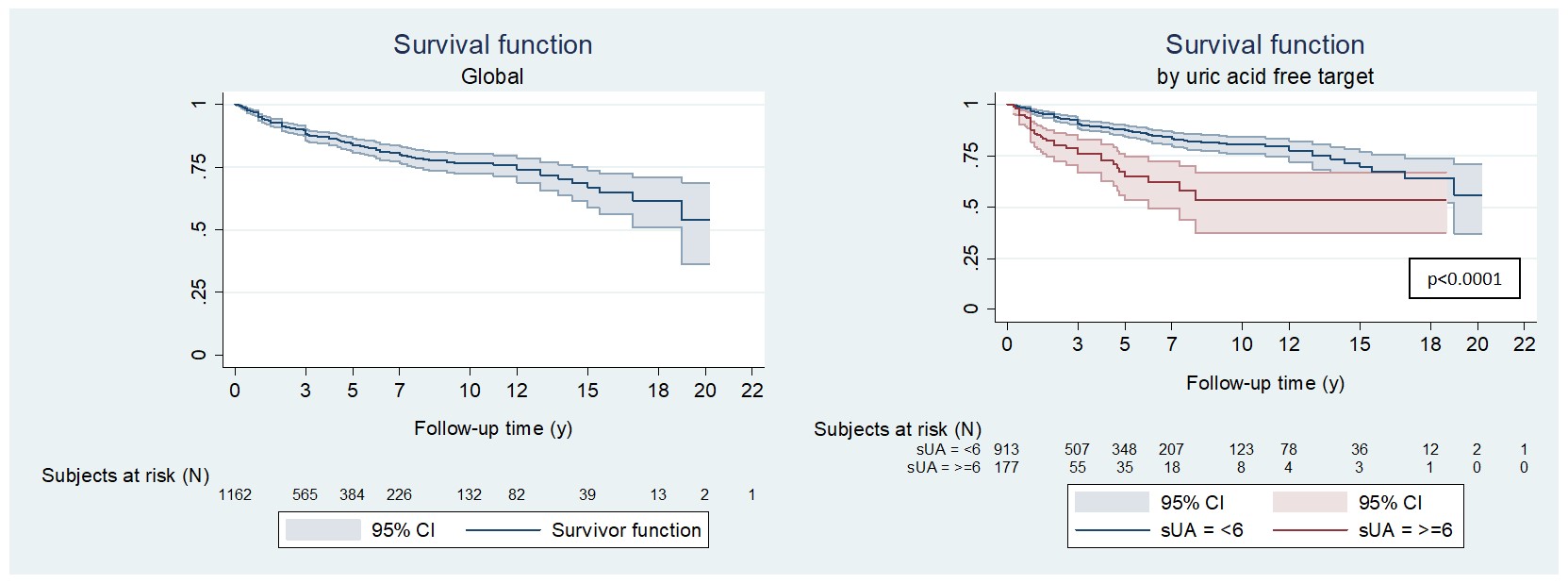Session Information
Date: Sunday, October 21, 2018
Title: 3S083 ACR Abstract: Metabolic & Crystal Arthropathies: Comorbidities & Outcomes (869–874)
Session Type: ACR Concurrent Abstract Session
Session Time: 2:30PM-4:00PM
Background/Purpose: Gout is associated with an increased risk of cardiovascular events and death. It has been shown that both overall and risk of death are associated with increasing gout severity, as reflected by the number of tophi. It remains to be proven whether better control of gout through lowering of serum uric acid (sUA) confers a survival advantage. To determine the impact of achieving sUA less than 6 mg/dl (vs greater) on mortality risk among gout patients.
Methods: Analysis of data from a prospective follow-up cohort (1992 to 2017) of patients attending a gout clinic (85% of patients with microscope or ultrasound diagnosis) and with at least one follow-up visit. Mortality was confirmed from medical records, patients’ families, or local death registries if needed. sUA levels were monitored during follow-up and the average sUA until sUA was stable was used as the primary exposure dichotomized as < 6 mg/dl (versus > 6 mg/dl). Descriptive variables and potential confounders included: age, gender, body mass index, previous treatment with urate-lowering drugs (ULDs), number of joints affected at entry, presence of subcutaneous tophi, radiographic evidence of articular damage, number of gout flares in the year preceding evaluation, previous diagnosis of cardiovascular (CV) disease, loop diuretic use, alcohol intake, diabetes, hypertension, hyperlipidemia, and renal function impairment. In addition, the Kaiser Permanente stratification of comorbidity was further used to risk stratify patients from low to high risk of death. Univariate and multivariate Cox proportional hazards models were used to determine mortality risks expressed a hazard ratios (HR) and 95% Confidence Intervals (CI).
Results: The study cohort included 1,193 patients (92% men, mean age 60, 6.8 years disease duration, with an average of 3 to 4 flares in the previous year). Mean follow-up was 48 (median 30, IQR 12-66), with 4,830 patient-year observation. Mean sUA at baseline was 9.1 mg/dl and 16.3% of the patients maintained sUA levels ≥6 mg/dl despite treatment. A total of 158 deaths occurred (13% overall mortality), with loss to follow-up in 286 cases (24%). Overall crude mortality rate was 32.7 per 1,000 patient-years, (95% CI: 28.0-38.2) and was significantly higher for patients with sUA ≥ 6 mg/dl, 80.9 per 1, 000 person years (95% CI 59.4-110.3) compared to patients with sUA <6 mg/dl, 25.7 per 1,000 person-years (95% CI: 21.3-30.9). With adjustment for age, sex, previous CV events, and baseline sUA concentration, a sUA ≥ 6 mg/dl was associated with a HR of 2.39 (1.64 – 3.50).
Conclusion: Failure to reach a target sUA level of 6 mg/dl is an independent predictor of mortality in gout patients. Control of gout with achievement of sUA target <6 mg/dl should be considered in order to improve patient survival.
To cite this abstract in AMA style:
Perez-Ruiz F, Richette P, Stack A, Karra Gurunath R, GARCIA DE YEBENES Y PROUS MJ, Carmona L. Failure to Reach Serum Urate Target Is Associated with Elevated Mortality in Gout [abstract]. Arthritis Rheumatol. 2018; 70 (suppl 9). https://acrabstracts.org/abstract/failure-to-reach-serum-urate-target-is-associated-with-elevated-mortality-in-gout/. Accessed .« Back to 2018 ACR/ARHP Annual Meeting
ACR Meeting Abstracts - https://acrabstracts.org/abstract/failure-to-reach-serum-urate-target-is-associated-with-elevated-mortality-in-gout/

